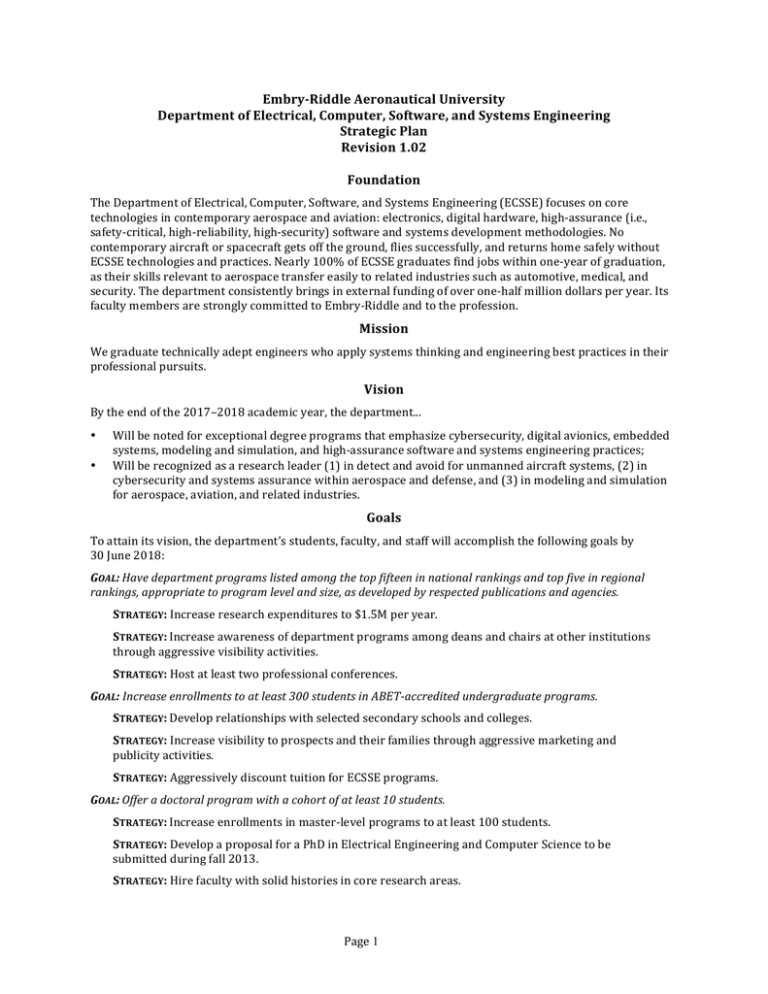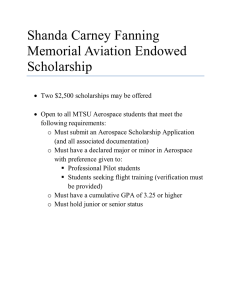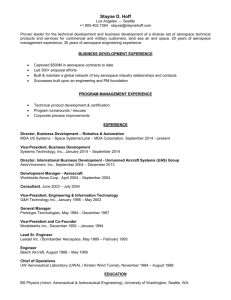Department of Electrical, Computer, Software, and Systems
advertisement

Embry-­‐Riddle Aeronautical University Department of Electrical, Computer, Software, and Systems Engineering Strategic Plan Revision 1.02 Foundation The Department of Electrical, Computer, Software, and Systems Engineering (ECSSE) focuses on core technologies in contemporary aerospace and aviation: electronics, digital hardware, high-­‐assurance (i.e., safety-­‐critical, high-­‐reliability, high-­‐security) software and systems development methodologies. No contemporary aircraft or spacecraft gets off the ground, flies successfully, and returns home safely without ECSSE technologies and practices. Nearly 100% of ECSSE graduates find jobs within one-­‐year of graduation, as their skills relevant to aerospace transfer easily to related industries such as automotive, medical, and security. The department consistently brings in external funding of over one-­‐half million dollars per year. Its faculty members are strongly committed to Embry-­‐Riddle and to the profession. Mission We graduate technically adept engineers who apply systems thinking and engineering best practices in their professional pursuits. Vision By the end of the 2017–2018 academic year, the department... • • Will be noted for exceptional degree programs that emphasize cybersecurity, digital avionics, embedded systems, modeling and simulation, and high-­‐assurance software and systems engineering practices; Will be recognized as a research leader (1) in detect and avoid for unmanned aircraft systems, (2) in cybersecurity and systems assurance within aerospace and defense, and (3) in modeling and simulation for aerospace, aviation, and related industries. Goals To attain its vision, the department’s students, faculty, and staff will accomplish the following goals by 30 June 2018: GOAL: Have department programs listed among the top fifteen in national rankings and top five in regional rankings, appropriate to program level and size, as developed by respected publications and agencies. STRATEGY: Increase research expenditures to $1.5M per year. STRATEGY: Increase awareness of department programs among deans and chairs at other institutions through aggressive visibility activities. STRATEGY: Host at least two professional conferences. GOAL: Increase enrollments to at least 300 students in ABET-­‐accredited undergraduate programs. STRATEGY: Develop relationships with selected secondary schools and colleges. STRATEGY: Increase visibility to prospects and their families through aggressive marketing and publicity activities. STRATEGY: Aggressively discount tuition for ECSSE programs. GOAL: Offer a doctoral program with a cohort of at least 10 students. STRATEGY: Increase enrollments in master-­‐level programs to at least 100 students. STRATEGY: Develop a proposal for a PhD in Electrical Engineering and Computer Science to be submitted during fall 2013. STRATEGY: Hire faculty with solid histories in core research areas. Page 1 ECSSE Strategic Plan 28 August 2013 Research Justifications Why detect and avoid? The detect-­‐and-­‐avoid (DAA) research direction supports the mission of the university and college to expand the body of research in unmanned and autonomous systems. Detect-­‐and-­‐avoid research currently focuses upon efforts to mitigate the risk of mid-­‐air and ground-­‐based collisions of UAS with other aircraft, terrain, and ground infrastructure. However, its research has a broader applicability including situational awareness and collision avoidance for unmanned ground robots, autonomous vehicles, unmanned underwater vehicles, unmanned surface vehicles, etc. Technologies that improve the safety of unmanned and autonomous systems often have direct applicability to their manned counterparts, which can result in new safety systems that benefit the broader public. DAA research aligns well with the research capabilities and interests of the ECSSE Department including, but not limited to: unmanned and autonomous systems, remote sensing, modeling and simulation, artificial intelligence, multi-­‐agent systems, avionics, and highly-­‐reliable dependable systems. Why cybersecurity and system assurance? Cybersecurity and systems assurance has become a priority area for many nations and the trend for its importance is every increasing. The ubiquitous availability of computer-­‐ based systems and increased deployment of autonomous systems present Embry-­‐Riddle Aeronautical University and the Department of Electrical, Computer, Software, and Systems Engineering with unique opportunities. This is particularly true due to the safety emphasis of the aviation and aerospace industries, and focus on real time, safety critical, systems within the ECSSE department. The cybersecurity and systems assurance research area, due to its impact in a wide range of areas, would also be supporting the other research niches in the department and the university. This area has potential to involve a wide range of participants from various programs and units in the university. Successful pursuit of this research area will enhance the department’s and the university’s visibility while providing opportunities for our students in both undergraduate and graduate programs. As cybersecurity and systems assurance knowledge is highly desirable in today’s graduates, our students would be better prepared for their professional careers. The research and educational activities pursued in this area would aid in meeting the need for local, state, and national needs. Why modeling and simulation? Modeling and simulation is widely applied in aerospace, aviation, and related industries. Its practice is core to contemporary engineering development, business operations, and financial practices. The ability to explore design alternatives, prospective enterprise organizations and strategies for conduct, and the impact of large numbers of parameters on possible outcomes gives advantage to those who employ modeling and simulation in a wide variety of applications over their competitors. Through recent faculty hires in the ECSSE department and at ERAU’s NEAR lab, our modeling and simulation capabilities are enhanced to the point of supporting major research initiatives applying modeling and simulation in aerospace, aviation, and related fields. Page 2 Rev 1.2


